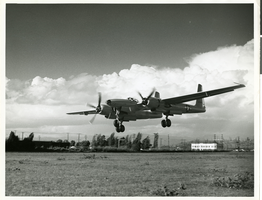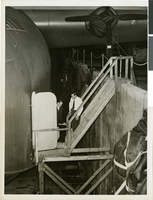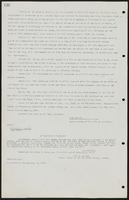Search the Special Collections and Archives Portal
Search Results

Photograph of Hughes XF-11 in flight, April 4, 1947
Date
1947-04-04
Archival Collection
Description
Date stamped on back of photo: April 3, 1947. Transcribed from attached press release: "HUGHES FLIES DUPLICATE OF CRASH PLANE CULVER CITY, Calif., April 5 -- Howard Hughes, famed flier-industrialist, today test-piloted the plane pictured here, a duplicate of the XF-11 photo-reconnaissance ship which he nearly lost his life in an accident last July 7. He designed and built the plane for the Army Air forces in conjunction with the Air Materiel Command engineers. He has recovered from the injuries sustained last year when the freak propeller trouble dashed the original XF-11 to earth. As usual, he today took personal responsibility for the first test flight of the new plane." The actual flying date is April 4, 1947.
Image

Photograph of Howard Hughes and Joe Petralli inspecting the HK-1, Hughes Flying Boat, as it nears completion, 1947
Date
1947
Archival Collection
Description
Howard Hughes (left, in dark coat) noted designer, builder, and industrialist entering the hull of the Hughes Flying Boat, the largest airplane in the world, as it was nearing completion on Terminal Island in the Los Angeles Harbor. With him is Joe Petralli, assistant director of service and flight.
Image

Transcript of interview with Hugh E. Key by Bob Bush, February 21, 1980
Date
1980-02-21
Archival Collection
Description
On February 21, 1980, collector Bob Bush interviewed porter and retired military man, Hugh E. Key (born on November 17th, 1919 in Fordyce, Arkansas) in Las Vegas, Nevada. This interview covers the life of a Las Vegas old-timer. Hugh Keys’ wife, Mrs. Key, is also present during the interview and offers a few remarks.
Text
Annual Financial Report; Fiscal Year July 1, 1972 to June 30, 1973 by City of Boulder City, Nevada/ Logan, Alex C. A. & Co., LTD., 1972 July 01 to 1973 June 30
Level of Description
File
Archival Collection
Clark County Planning Commission Research Library Collection
To request this item in person:
Collection Number: MS-01027
Collection Name: Clark County Planning Commission Research Library Collection
Box/Folder: Box 85
Collection Name: Clark County Planning Commission Research Library Collection
Box/Folder: Box 85
Archival Component
Hughes Electronics/Hughes Aircraft Company newsletters, 1970 to 1999
Level of Description
File
Archival Collection
Hughes Aircraft Retirees Association Records
To request this item in person:
Collection Number: MS-01146
Collection Name: Hughes Aircraft Retirees Association Records
Box/Folder: Box 04
Collection Name: Hughes Aircraft Retirees Association Records
Box/Folder: Box 04
Archival Component
Howard Hughes at his desk at Hughes Aircraft Company, 1947
Level of Description
File
Archival Collection
Howard Hughes Professional and Aeronautical Photographs
To request this item in person:
Collection Number: PH-00321
Collection Name: Howard Hughes Professional and Aeronautical Photographs
Box/Folder: Folder 04
Collection Name: Howard Hughes Professional and Aeronautical Photographs
Box/Folder: Folder 04
Archival Component
Hughes Space and Communications "This is Hughes" Mandarin, 1996 October 22
Level of Description
File
Archival Collection
Hughes Electronics Corporation Records
To request this item in person:
Collection Number: MS-00485
Collection Name: Hughes Electronics Corporation Records
Box/Folder: Box 13
Collection Name: Hughes Electronics Corporation Records
Box/Folder: Box 13
Archival Component
Description of Hughes Aircraft Company - GMHE / Hughes / Delco, 1986
Level of Description
File
Archival Collection
Hughes Electronics Corporation Records
To request this item in person:
Collection Number: MS-00485
Collection Name: Hughes Electronics Corporation Records
Box/Folder: Box 01
Collection Name: Hughes Electronics Corporation Records
Box/Folder: Box 01
Archival Component
Pagination
Refine my results
Content Type
Creator or Contributor
Subject
Archival Collection
Digital Project
Resource Type
Year
Material Type
Place
Language
Records Classification


